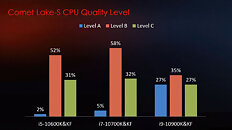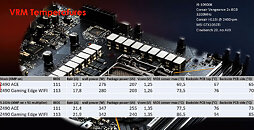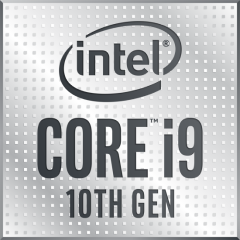- Joined
- Oct 9, 2007
- Messages
- 47,749 (7.42/day)
- Location
- Dublin, Ireland
| System Name | RBMK-1000 |
|---|---|
| Processor | AMD Ryzen 7 5700G |
| Motherboard | Gigabyte B550 AORUS Elite V2 |
| Cooling | DeepCool Gammax L240 V2 |
| Memory | 2x 16GB DDR4-3200 |
| Video Card(s) | Galax RTX 4070 Ti EX |
| Storage | Samsung 990 1TB |
| Display(s) | BenQ 1440p 60 Hz 27-inch |
| Case | Corsair Carbide 100R |
| Audio Device(s) | ASUS SupremeFX S1220A |
| Power Supply | Cooler Master MWE Gold 650W |
| Mouse | ASUS ROG Strix Impact |
| Keyboard | Gamdias Hermes E2 |
| Software | Windows 11 Pro |
MSI in its weekly "MSI Insider" livestream shared fascinating insights into the way Intel appears to be sorting out its "Comet Lake" silicon across the various brand extensions of its 10th generation Core desktop processors. Its tech leads Eric Van Beurden and Michiel Berkhout spoke at length about MSI's own evaluation of the trays of Core i5-10600K/KF, i7-10700K/KF, and i9-10900K/KF chips it received (the only unlocked chips across the lineup), which they used as empirical evidence to suggest a model for Intel's binning.
MSI segregated the chips it received into three categories. Level A consists of chips that overclock higher than Intel's specifications (overclocking headroom higher than expected). Level B consists of those that overclock within Intel's specifications. Level C, on the other hand, have their overclocking headroom fall below Intel's specifications. It's important to note here that "Intel specification" doesn't mean "stock frequencies," it refers to the overclocking headroom Intel communicates to motherboard manufacturers, to give them an idea of the minimum board design requirements needed to guarantee overclocking within these specifications, for their Z490 motherboards. These are more of a guideline in nature, all three levels will overclock above stock frequencies.



In its testing, MSI found that only 2% of the i5-10600K/KF chips went above and beyond Intel specifications, qualifying for Level A. For the i7-10700K/KF, this number stands at only 5%. It's only with the i9-10900K/KF that the number shoots up to 27%. So your chances of getting a golden i5-10600K/KF or i7-10700K/KF are rather slim.
Moving on, a majority of both the i5-10600K/KF and i7-10700K/KF overclock within Intel specifications, with 52% of the i5-10600K/KF qualifying for Level B, and 58% of the i7-10700K/KF. 35% of the i9-10900K/KF qualify for this bin. Lastly, nearly 1/3rd of all three chips fall below Intel specifications, ending up in Level C. That's 31% of the i5-10600K/KF, 32% of the i7-10700K/KF, and 27% of the i9-10900K/KF.
The distribution of the three bins is a lot more uniform with the i9-10900K/KF than it is with the i7-10700K/KF and the i5-10600K/KF, and so MSI suggests that you have a much better chance of landing a good Level B or great Level A chip with the i9-10900K/KF. Level C taking up nearly 1/3rd of all three chips is a cause for concern indeed.
The second graph (above) talks about the voltage vs. average package power relationship among the three bins, to show you just how stark the differences between Level A and Level C are.
Find more comments by MSI in the video below.
View at TechPowerUp Main Site
MSI segregated the chips it received into three categories. Level A consists of chips that overclock higher than Intel's specifications (overclocking headroom higher than expected). Level B consists of those that overclock within Intel's specifications. Level C, on the other hand, have their overclocking headroom fall below Intel's specifications. It's important to note here that "Intel specification" doesn't mean "stock frequencies," it refers to the overclocking headroom Intel communicates to motherboard manufacturers, to give them an idea of the minimum board design requirements needed to guarantee overclocking within these specifications, for their Z490 motherboards. These are more of a guideline in nature, all three levels will overclock above stock frequencies.



In its testing, MSI found that only 2% of the i5-10600K/KF chips went above and beyond Intel specifications, qualifying for Level A. For the i7-10700K/KF, this number stands at only 5%. It's only with the i9-10900K/KF that the number shoots up to 27%. So your chances of getting a golden i5-10600K/KF or i7-10700K/KF are rather slim.
Moving on, a majority of both the i5-10600K/KF and i7-10700K/KF overclock within Intel specifications, with 52% of the i5-10600K/KF qualifying for Level B, and 58% of the i7-10700K/KF. 35% of the i9-10900K/KF qualify for this bin. Lastly, nearly 1/3rd of all three chips fall below Intel specifications, ending up in Level C. That's 31% of the i5-10600K/KF, 32% of the i7-10700K/KF, and 27% of the i9-10900K/KF.
The distribution of the three bins is a lot more uniform with the i9-10900K/KF than it is with the i7-10700K/KF and the i5-10600K/KF, and so MSI suggests that you have a much better chance of landing a good Level B or great Level A chip with the i9-10900K/KF. Level C taking up nearly 1/3rd of all three chips is a cause for concern indeed.
The second graph (above) talks about the voltage vs. average package power relationship among the three bins, to show you just how stark the differences between Level A and Level C are.
Find more comments by MSI in the video below.
View at TechPowerUp Main Site








